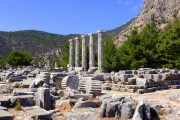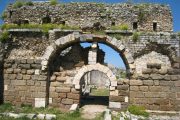Duration of the tour: Approximately 6 hours.
Departing from: Port of Kusadasi
Service level: Private Tour
| Departure/Return Location |
Kusadasi / Kusadasi | ||||
| Service Level |
Private Tour | ||||
| Tour Included |
|
||||
| Tour Not Included |
|
After your cruise docked to Kusadasi port, on your meeting time, your guide will be waiting you in the arrival guest terminal with a sign that your booking name indicated. After he/she welcomes you and after getting on your private van, your unforgetable day in Turkey stop starts.
First of all you follow the way to Soke town for your first stops where the Ancient Cities of Priene and Miletus exixts. After 30 minutes driving you reach to a pretty village called as Gullubahce to start your day with visiting the Ancient City of Priene located on Mount Mycale (Samsun) and contained many famous examples of Hellenistic art and architecture.
You are going to get very impressed with the location of this small city on the slopes of the mountain in the nature surrounded with huge pine trees everywhere…
Priene was one of the 12 Ionian cities that settled to the western coast of Anatolia. The original location of the city has never been found but it was probably a peninsula with two harbors.
By the 8th century BC Priene was a member of the Ionian League. The League’s central shrine, the Panionion, lay within the city’s boundaries, making Priene an important holy city.
Alexander the Great in 334 stayed in Priene during his lengthy siege of Miletus. Another famous person of Priene was the philosopher Bias, one of the Seven Sages of Greece, who was born here.
Your guide will make a round trip inside the city with the visits and informations of the ruins such as ; the parts of the Hellenistic City Walls, Egyption Temples, Grand Theater, remains of a Byzantine Basilica and Bath complex, The Temple of Athena Polias, ruins of The Private Houses, The Agora, The Buleterion, The Pretaneion, The Gymnasion and more…
After visiting this impressive city, your next stop comes as the Ancient City of Miletos exixts. After 15 minutes driving, the big impressive grand theater of the city welcomes you with all its glory…
Once the city of famous philosophers in history such as; Thales, Anaximander and Anaximenes, all philosophers of nature and the universe; the historian and geographer Hekataios, who first used the word “history” in its modern sense; and Isidorus, one of the designers of the Hagia Sophia.
Excavations in Miletus started by French archaeologists in 1868, while significant research has been carried out since 1899 under the auspices of the German Archaeological Institute.
Miletus was one of the most important city of Ionia. St. Paul stopped at Miletus on his Third Missionary Journey, on his way back to Jerusalem. (Acts 20:16-38) He was on his way back to Jerusalem, and in a hurry because he wanted to reach the holy city by the day of Pentecost. Coming from Troas, he bypassed Ephesus but paused at Miletus and called for the elders of Ephesus to come meet him there.
Miletus was located on the coast at the mouth of the River Meander with four harbors. The strategic location on the west coast of Asia Minor made it a major player in the commerce of the ancient world. It was also continuously captured by lots of different invaders. But eventually, Miletus met its fate not at the hands of foreign powers but the gentle Meander River, which silted up the ports of the city over the centuries and made the city to become an inland with its location.
Miletus was first occupied in 1400 BC by Minoans from Crete, then Mycenaeans from the Peloponnese, then by refugees from Greece who were the Ionian trying to escape from the Dorian invasions. Miletus became the most important of the 12 cities of Ionia, and was one of the first cities in the ancient world to mint coins. It was mentioned by Homer in The Iliad (II.868).
After learning about the important history about Miletus, first impressive building from the city left that you are going to be meeting will be the big grand theater which was originally built in the 4th century BC, but modified and enlarged under Emperor Trajan in the 2nd century AD to seat 20,000 -25,000 spectators. Also added in the Roman period was a third floor to the stage building, which was decorated with columns and hunting scenes with Eros. In the center of the first two rows, four columns designated a special box for the emperors. Also even during the Byzantine time, a Byzantine Castle was built on the top of the seating areas in the 7th C AD. So in this massive building you see three different time periods construction additions at once.
Climbing up the stairs of the theater you will face the ruins of the city left from an edge of the hill behind the theater panaromicly and your guide informs you about them all such as; The Lion Harbor, a Hellenistic heroon, Baths of Faustina, the Byzantine Church of St. Michael, the agora, Temple of Serapis, The Sacred Way begins at the Harbor Gate and extended to Didyma with 12 miles(20 km) distance and The Delphinion. The inhabitants of Miletus traveled this route each year for a pilgrimage to the Temple of Apollo.
The Delphinion was the main temple in Miletus. A shrine to Apollo Delphinios (Apollo of the Dolphins), protector of ships and harbors, it was in use by Greek times if not before. It was a rectangular enclosure bordered by two-aisled stoas at the north, east and south. The round base in the center of the courtyard is thought to belong to a Roman-era heroon (temple of a hero). The Delphinion leads onto to the processional way to the Temple of Apollo at Didyma.
Another well preserved structre that you continue to visit inside the ancient city will be the Baths of Faustina where you do see all the different sections of an old Roman bath and learn about the functions and importance of the baths back in those days.. It was built by the order of the wife of Marcus Aurelius in 164 AD. In this large complex you see charming water fountains in the shape of the river god Meander and a small lion, and niches in the “Hall of the Muses” that once held statues of Apollo, Asclepius, Telesphorus, the nine Muses and a head of Aphrodite.
After visiting the Bath of Faustina you will follow the way back to the parking area with your guide and take the drive to famous Didyma to see the huge ruins of the Temple of Apollon.
Approximately 20 minutes driving, you start seeing the huge massive columns of this magnicient temple dedicated to the Greek god Apollon who was also the twin brother of Greek goddess Artemis.
Didyma means “twin” and refers to the twins Apollo and Artemis, who were born to Zeus and Leto.
The Oracle of Apollo at Didyma rivaled that of Delphi; pilgrims flocked to Didyma not only to worship Apollo and attend the festival, but also to find answers about their future. Famous persons known to have visited Didyma’s Temple of Apollo include Alexander the Great’s generals Lysimachus and Seleucus I, and the Roman emperors Augustus and Trajan.
Wait to see this temple with its splendour and wait to learn more from your guide…
As ending your tour with impressive informations and wonderful pictures that you had in these three sites, you meet with your private van in the parking area and you start driving approximately 45 minutes to reach back to Kusadasi where the port is. Finally dropping you off back to the port will be ending our services as saying goodbye to our guests with unforgetable memories and with the wishes to welcome them back again…
1- Ephesus has approximately 1 mile (1,5 km) walking distance and Terrace Houses(if the visit included) has more than 200 steps. Not recommended for our guests who have physical disabilities.
2- During your visits in the historical sites you need to wear comfortable shoes because there going to be cobblestone and slippery surfaces, inclines and sometimes steps.
3- During the tours having a hat and putting your sunscreens on highly recommended to avoid the problems in the hot temperatures. Especially inside Ephesus possiblities to find shade is difficult.
According to your request, we can skip some of the sights from the program.
4- Teracce Houses are located inside the ancient city of Ephesus and has an extra enterence fee as a museum. If it is not indicated in your program that you selected and if you desire to visit it, in any of the tours could be added optionally as long as you pay for the enterence fee.
5- According to the crowds on the busy days, your experienced tour guide could change the rotation of the places to visit in your program to organise a much easier day for your comfort.
6- Local currency is Turkish Liras(TL) but around the places where you visit, generally they do accept euros and dollars.
7 – 0-6 ages of children are free of charge as long as you bring the copies of their passports to show the officials at the enterances of each site.
8- If there is a mosque visit in your program, you should bring a scarf to wear before you enter.












Tour Reviews
There are no reviews yet.
Leave a Review